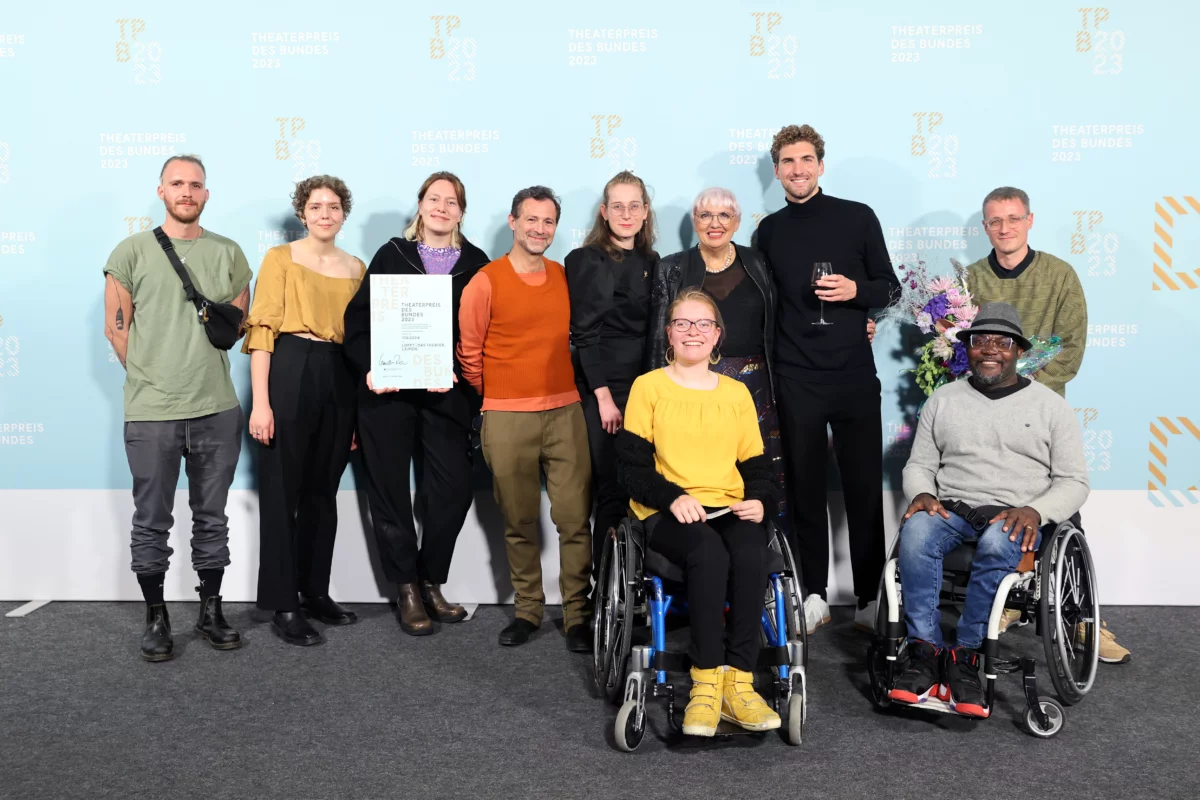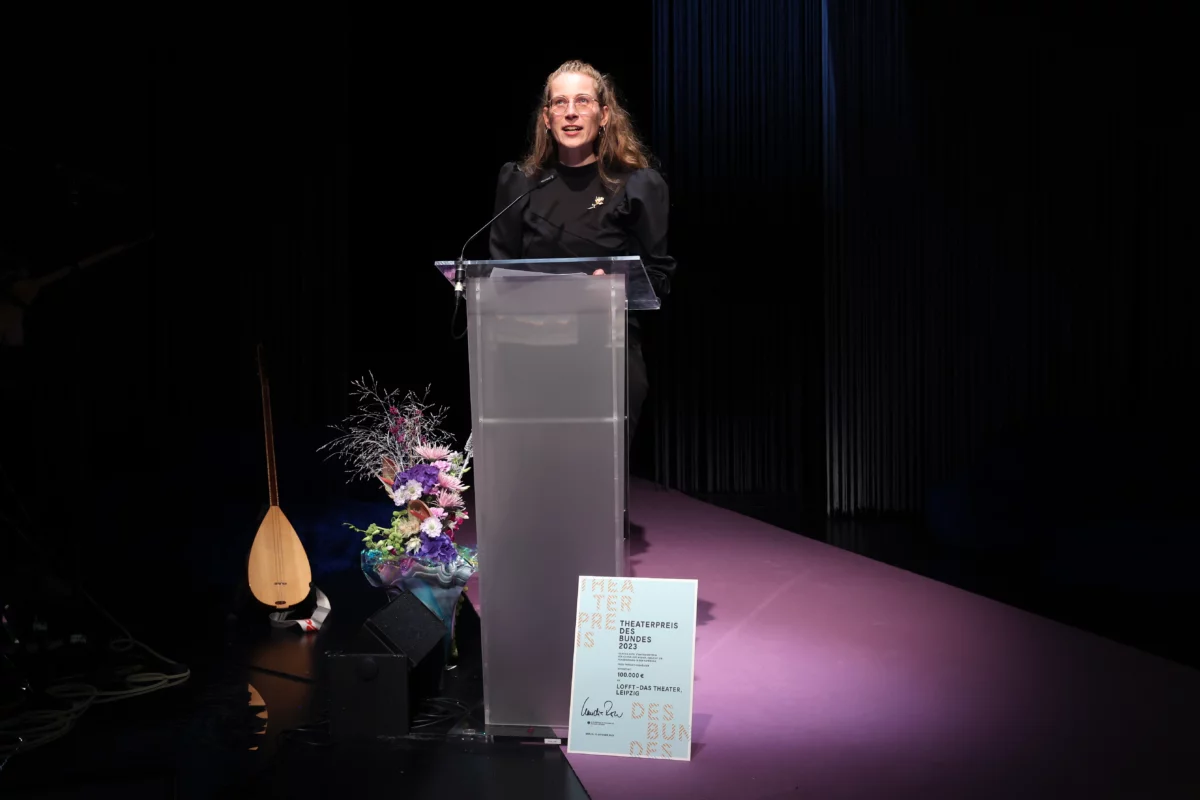The Vibe of Leipzig
By Christine Wahl
Anne-Cathrin Lessel, the creative director of LOFFT, and Sebastian Weber, choreographer and dancer of the Sebastian Weber Dance Company, in conversation with Christine Wahl on being awarded the Federal Theater Prize in the "Independent Production Houses" category.
Ms. Lessel, congratulations on receiving the Theaterpreis des Bundes award in the category of independent production houses! The jury honored your theater, the LOFFT in Leipzig, as "one of the formative and exemplary nodes on the mental map of the independent performing arts". Since 2019, the LOFFT has been located on the site of the Baumwollspinnerei, a former cotton mill where many visual artists also have their studios. So, can we assume that networking starts right in your neighborhood and that you regularly sit with icons of the Leipzig School like Neo Rauch in the theater foyer?
Anne-Cathrin Lessel: There are definitely points of contact with key players from the Spinnerei. We work with some of them on a one-off basis and on certain projects, with others even regularly. For example, a gallery owner is on our artistic advisory board, because we find interdisciplinary perspectives important for the selection of our projects. But it's not like we just go out for a beer with Neo Rauch.
Mr. Weber, you have been closely associated with the LOFFT as an artist for many years and even know it from when it was founded in the mid-1990s. You have realized many of your own projects here and were involved in the board for a while yourself. How do you view the still comparatively young neighborhood of the Leipzig School?
Sebastian Weber: For me, the fact that the LOFFT is now located on the Spinnerei site has a few other implications. When I moved to Leipzig from Cologne 25 years ago, there were many more undeveloped buildings, and the Spinnerei – although already in the hands of engaged investors – was also a lot wilder. Nevertheless, even back then you didn't sit here with Neo Rauch over a beer. Because apart from the fact that he has no desire to do so, the expensive pictures that are painted here are not at all the key factor for me when it comes to the Baumwollspinnerei. Instead, it's a place that exemplifies transformation. In that respect, it's a perfect fit for the LOFFT.
Can you be more specific?
Weber: The LOFFT is a place where there are many possibilities, where you can grapple with and change something. And for me, this feeling is actually also the vibe of Leipzig in general: If you really want to, you can make something happen here. The city is big enough to have the potential to do so – and small enough that you can make the contacts and find the allies you need. Especially since people in Leipzig really do form alliances. Here, for example, there is an exemplary cooperation between the city's cultural office and the independent scene. Personal discussions take place and funding concepts are developed together – over years! If I'm informed correctly, Leipzig spends more money on the independent scene, measured in terms of tax revenue, than any other city in Germany.
 © Dorothea Tuch
© Dorothea Tuch
The team of LOFFT - Das Theater with Minister of State for Culture Claudia Roth
And the LOFFT acts as an anchor point and core institution in this scene: It is equally a production house, event organizer and guest performance venue, promoter of young talent and lobbyist for the independent arts, and even offers tax advice for artists. Which of these many aspects is most important to you, Ms. Lessel?
Lessel: The essential thing – especially in contrast to theaters that primarily show guest performances – is that we really do see ourselves as enablers for artists. We take care of the local up-and-coming scene, help actors develop their projects, and support all artistic production contexts.
A gigantic all-round program!
Lessel: Funnily enough, we are often mentioned in the same breath as institutions that are on the same level as state theaters. Because we are comparatively networked and international and are involved everywhere, people always think we are massive. When I then say that we run our entire operation with 12 permanent employees, people are speechless. Of course, this only really works because everyone who works here is incredibly committed to art and no one puts their own interests first. That was already the case before I took on this leadership role, and it's part of the theater’s DNA.
Mr. Weber, what specifically makes the LOFFT attractive to you as an artist?
Weber: What I value enormously is the nationwide horizon that is opened up here. The LOFFT is not a theater that only shows colleagues from the neighborhood, but one that is networked nationally, and accordingly also puts its co-productions out to tender nationwide, and as a result also sometimes has to endure conflict with the local scene. As an audience member, but also as a choreographer and dancer, it is enormously inspiring for me that I get to see a handpicked selection of players from across the country at the LOFFT. This always gives you a bit of an artistic push yourself. The LOFFT is simply not a sofa you can snuggle into, but a place that seriously challenges you.
Can you give an example?
Weber: It already starts with the fact that there is no artistic directorate here that holds the decision-making power, but rather the artistic program is decided by an advisory board. First of all, I find that highly democratic, and secondly, I like the willingness to take risks that is inherent in this model: You might invest in a co-production that doesn't turn out the way you had hoped. I'm firmly convinced that that's what makes a good place for contemporary art: If there's always only success, something's not right; then people aren't brave enough.
Ms. Lessel, how do you feel about the advisory board as the director of the theater?
Lessel: (Laughs) The model is definitely a challenge! Because, of course, sometimes concepts are selected that I personally would not have chosen – or, almost more regrettably, projects are not selected that I would have loved to be involved in and that then perhaps are resounding successes a year later at another theater. But that's just the model – and it's unique. I don't know of any other independent theater in Germany whose core program – which for us is eight to 10 productions a year – is selected by such a broad committee, currently 10 different personalities from the arts, culture and our networks.
 © Dorothea Tuch
© Dorothea Tuch
Anne-Cathrin Lessel (Artistic Director and Management) accepts the award on behalf of LOFFT.
For historical reasons, institutions like the LOFFT have a much stronger presence in West German states than in East German ones, for example in North Rhine-Westphalia. In the East, the structures are simply younger because there was no institutionalized independent scene in the GDR. Is the East-West difference noticeable in your everyday work?
Weber: I think there is definitely still a difference between East and West. Although these categories should have ceased to play a role a long time ago, everyone knows, of course, that unfortunately they still do. This is visible, for example, in the fact that six out of the seven most prestigious theaters are located in the geographic west of the country. Or that at the German Dance Platform, the most important festival for contemporary dance, there are practically no companies from the former East Germany. Funding institutions such as the Kulturstiftung des Bundes have recognized this and are trying to respond accordingly. But the structures in the West have grown over decades and generations. Kampnagel in Hamburg or the Mousonturm in Frankfurt are unbelievably powerful institutions, and the Tanzhaus NRW could easily accommodate all the studios from Leipzig. Another point is civic engagement. If you look at the foundations in Hamburg or Baden-Württemberg alone...
Lessel: ... That's a very important point! Saxony has very few private foundations that support independent arts on their own. In the East, there is simply not (yet) the same capital for private-sector, civic involvement in cultural investment as there is in the West. There is a state cultural foundation that has to cover everything, from projects of the independent scene in the big cities to rural areas, from cultural education and the promotion of young talent to the preservation of the traditions of Saxon brass band music – all of which are enormously important missions. But then there simply isn’t much left over.
In other words, there is no shortage of investment opportunities for the 100,000 euros in prize money associated with the Theaterpreis des Bundes award.
Lessel: The money will definitely be reinvested in the arts, but we're still discussing exactly what form it will take. In fact, we always have a drawer full of ideas. But we were not only delighted about the money, but also about the recognition of our work!
Weber: This kind of national award is a confirmation of the importance of this theater, which is just incredibly beneficial – not only because there are state elections in Saxony next year and at the moment no one really knows how things will go in view of the awful poll numbers for the AfD. I think that behind all the work that Anne-Cathrin and the LOFFT do, there is the same driving force that we have in the dance company: Of course, we are actually in love with dance – as an aesthetic experience, as a physical feeling, and so on. But artistic activity is also always fueled by wanting to make a difference, to explore or test things that ultimately make the world a better place. That's why we also have to get out of the bubble, find new ways. That's the challenge for the future, and the LOFFT will definitely continue to inspire us in the process.